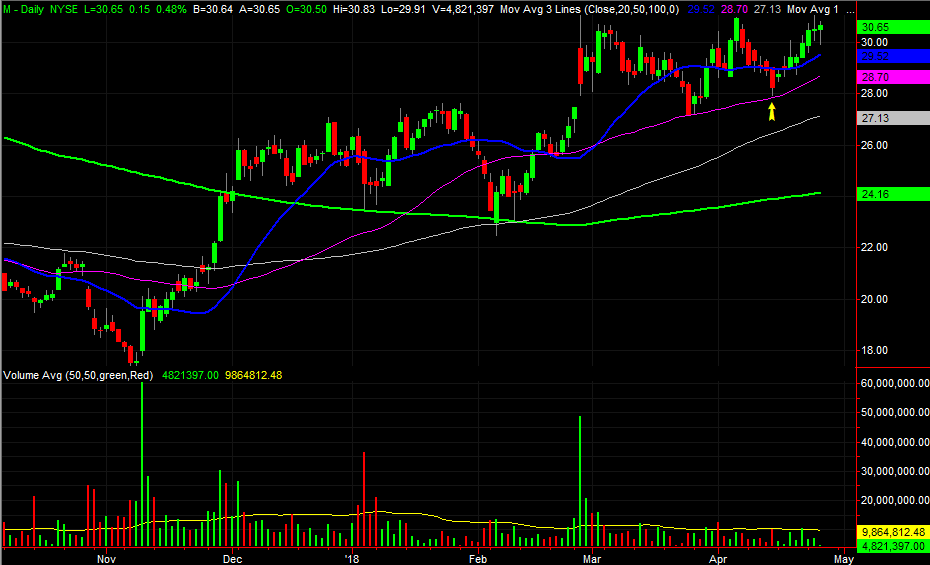Our Macy's Trade Illustrates the Power of Credit Spreads

Want to make some good money using put options to be bullish on stocks? That wasn't a misprint. There's a way to use bearish instruments to make a bullish trade. We know, because the BigTrends Credit Spread Trader Service just booked an almost-100% gain on such a trade. A closer look is merited, if only because of the underlying chart clue we saw that most other traders seemed to ignore.
But, first things first.... what the heck is a credit spread?
Credit Spreads Explained
If you're already well-versed in the art of esoteric option trades like credit spreads, feel free to skip to the next section 'Macy's Dropped the Right Hint.' The chart at the time was a good reminder that picking your entry spots probably shouldn't be a complicated matter. (In other words, your success as a trader is mostly decided by choosing to or not to trade, and how you play a trade.)
On the other hand, even veteran traders can benefit from a reminder lesson every now and then. So, if you can invest a couple of minutes in the refresher course, it would be time well spent.
The short(ish) definition of a credit spread: A two-legged option trade that involves the selling (short) of one option and the buying (long) of another option with a different strike price. Between the two you're a net seller, as the option you're shorting is worth more than the option you're buying. You'll pocket the "credit," or the difference between the two.
Why undergo such a complicated maneuver when you can simply buy a call or a put option? Because outright owning an option isn't necessarily as beneficial as it may seem. See, options lose value every day strictly due to time decay - also called 'theta' - so not only are you taking a risk in making a bet on a stock or index, you're also betting that the underlying move you're expecting will unfurl at a pace fast enough to overcome the gradual deterioration of an option's value over time.
With a credit spread, by selling an option (or being a net seller of options anyway), you're using time decay to your advantage because the faster that option loses value, the quicker you get to a profit, and the safer you're trade becomes.
Clear as mud? Let's walk through our actual trade on Macy's as a real-life case study.
How it Happened
The gist is, back on April 13th we had good reason to think shares of retailer Macy's (M) was poised to reverse a modest downtrend and move higher from its then-current price of $28.36. We weren't looking for a great move ... just a modest one. Ergo, the April 20th 27 (strike price) calls priced at $1.40 (or $140 per contract) wouldn't really do us much good. We were only looking more a move to a little better than $29, which would only translate into a value of about $2.36 a week later, and the value of the option itself was losing about three cents per day just due to time decay.
From a risk/reward perspective, it wasn't quite worth it.
As an alternative, we opted to sell the Macy's April 20th 27.5 puts (M 180420P27.5) for about a 67 cents each (or $67.00 per contract). Those calls were losing about two cents per day due to theta, or time decay, meaning we were gaining about two cents per day just for doing nothing other than sitting on the trade. Any value the puts also lost due to Macy's rise made the trade that much more profitable. Assuming Macy's shares were above $27.50 by the time the put options expired a week later, we'd be able to keep the whole 67 cents we collected on each contract we shorted.
It's not quite as bulletproof as it sounds. If we were wrong about M moving higher, we'd be caught holding a short put trade that theoretically had infinite risk. Remember, if we're short a put, we can be forced to buy Macy's shares at $27.50 regardless of the price of Macy's shares at the time.
The defense against that risk? We buy a slightly less expensive put option that we can exercise (or sell) should things go awry.
In this case, we opted for the Macy's April 20th 26.5 puts (M 180420P26.5), priced at 48 cents (or $48 per contract) at the time. Should M shares fall to, say $25.00 before expiration, the $27.50 calls we had shorted would surely be exercised against us, costing us money. But, we could also sell the $26.50 calls we owned for a profit that would offset the risk of the short leg of the trade.
The maximum risk with such a trade? Just the $1.00 difference between the two strike prices of the put options we traded. Not bad. And better yet, bear in mind we still would have kept the 19 cents (or $19 per contract) difference we collected as a credit at the trade's initiation. So, or maximum loss here would be 81 cents... and that assumes Macy's shares are trading below $26.50 upon expiration. That wasn't likely.
In fact, it didn't happen at all. We were able later to buy back the short 27.50 calls for two cents each, translating into a 17 cent gain (or $17 per contract) for each contract traded.
The 26.50 calls we owned we were more than happy to let expire, as they had no value then. That was the plan all along - the 26.50 calls were just an insurance policy. Like any insurance, you pay for it hoping you don't need to use it.
The only catch? You don't necessarily 'lock in' the credit on a credit spread until all the options expire, or until you at least unwind the short leg of the trade by buying it back. Even so, we collected 17 cents for every $1.00 we had to keep tied up for only a week. That's a pretty fair return on our capital, given the modest risk.
If you're confused, don't sweat it - credit spread trades sound and seem complicated. They're not, but that doesn't make them less overwhelming. The best way to make sense of them is to try a few on paper first, bearing in mind that for put credit spreads (a neutral-to-bullish trade) the option you're shorting has the higher strike, and the option you're buying is the one with the lower strike. More often than not, both strikes would be below the stock's current value... meaning they're both actually 'out of the money.'
Reverse that for a call credit spread, which are trades that assume a stock or index is destined to edge a little lower, or at least only move sideways.
Macy's Dropped the Right Hint
With all of that being said, it can't be overlooked that this trade's success was still ultimately rooted in making the right call on Macy's. So, let's at least acknowledge that and look at the chart.
The yellow arrow marks the entry point from the 13th. As you can see, all it took was a kiss of the 50-day moving average line (purple) to rekindle the uptrend that had begun in earnest several weeks earlier. In fact, the 50-day ling had already proven to be a technical support level just a few weeks prior, igniting a solid, trade-worth bounce in March.
Another solid clue that the bears really weren't serious about pulling the rug out from underneath Macy's: There was never really any strong selling volume with any of the occasional pullbacks we'd seen since the beginning of the year.
To that end, it's a nice reminder that for all the fancy, complex trades you can make using options, at the end of the day you still have to make the right call about a stock or index. That's still just as important is picking the right options when it comes to credit spreads.
If you'd like to lean on an experienced trading veteran to provide trading ideas for you as you 'learn by doing,' the BigTrends Credit Spread Trader service is ideally suited for trading newcomers that like the idea of credit spreads but still want help with the mechanics.

